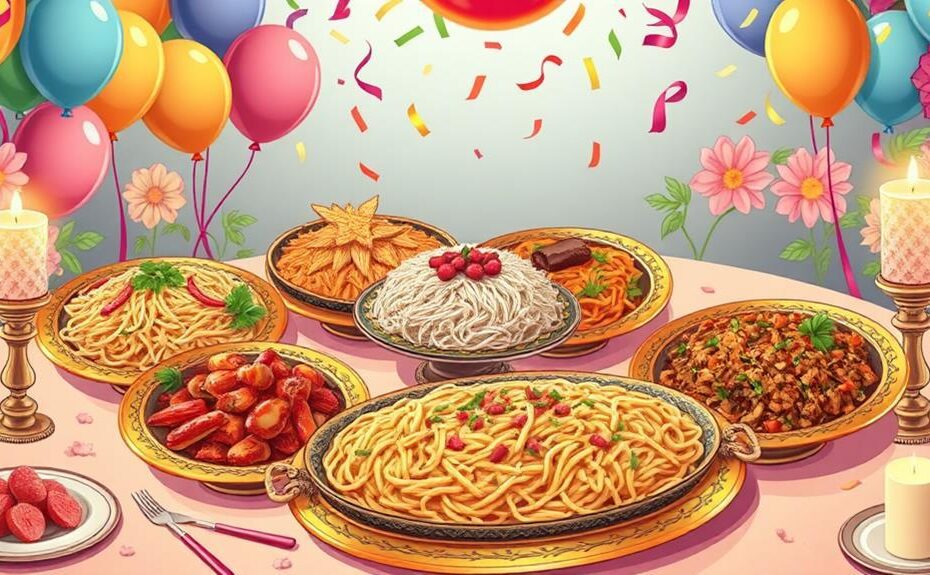Impress Your Guests with These Special Occasion Pancit Varieties
When choosing a Pancit dish for special occasions, select varieties that showcase unique flavors and cultural significance.
Pancit Bihon is a classic favorite, featuring thin rice vermicelli noodles, shrimp, chicken, and vegetables.
For a more festive atmosphere, Pancit Canton is a great option, with egg noodles, meats, and vegetables.
If you want to highlight seafood, Pancit Malabon is the way to go, with thick rice noodles and a seafood extravaganza.
Each variety guarantees an unforgettable celebration.
Pancit Bihon: A Classic Favorite
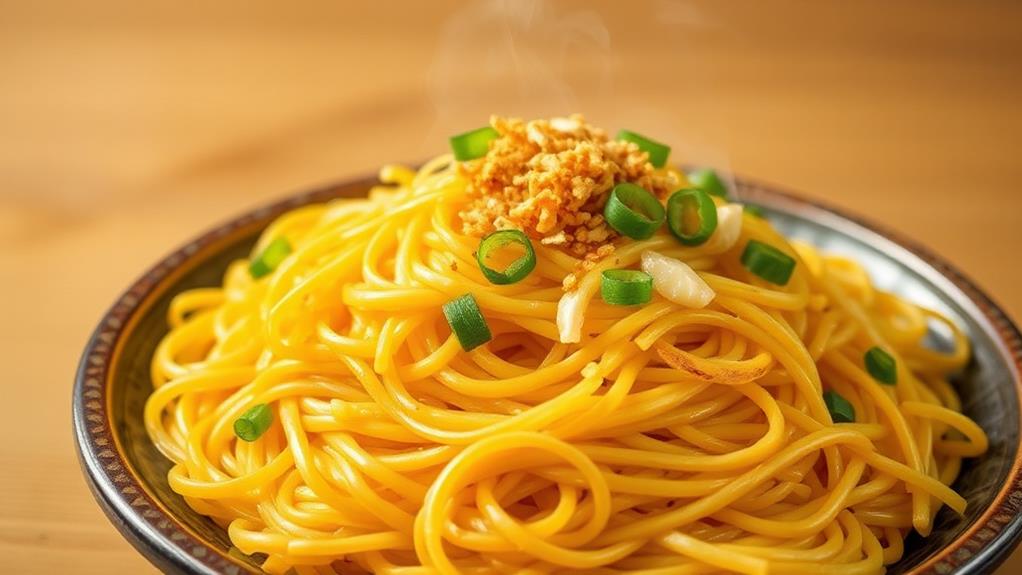
Pancit Bihon: A Timeless Filipino Noodle Dish
A Staple at Filipino Gatherings
Pancit Bihon is a traditional Filipino noodle dish that has been a staple at gatherings for generations.
This classic dish is made with thin rice vermicelli noodles, symbolizing long life and prosperity.
A Flavorful and Versatile Recipe
A typical Pancit Bihon recipe includes a mix of proteins like chicken, pork, and shrimp, along with vegetables like carrots, green cabbage, and snow peas.
These ingredients are seasoned with soy sauce and garlic, creating a savory and aromatic flavor profile.
Quick and Convenient to Prepare
Pancit Bihon is a convenient option for busy gatherings, taking around 30 to 45 minutes to cook.
Additionally, it's gluten-free and can be customized with various protein options, making it suitable for different dietary preferences.
A Crowd-Pleaser at Special Occasions
Pancit Bihon is a beloved favorite at special occasions, including birthdays, anniversaries, and holidays.
Its rich flavors and nostalgic charm make it a dish that's sure to satisfy.
Exploring Regional Pancit Varieties
The Philippines is home to a diverse range of regional pancit varieties, each with its unique twist and character.
Pancit Canton is a Filipino variation of Chow Mein that uses egg noodles instead of rice noodles and is stir-fried with various meats and vegetables, making it a festive favorite during birthdays and celebrations.
Pancit Malabon is known for its thick rice noodles and rich seafood toppings, often featuring shrimp and squid, making it a popular dish during festive gatherings, especially in Malabon City.
Pancit Habhab, originating from Quezon Province, is served on banana leaves and topped with sautéed vegetables and meat, celebrated for its local flavor and often enjoyed during festivals.
Pancit Sotanghon consists of glass noodles derived from mung beans and is commonly served during wakes and memorials, offering a light and savory taste that's suitable for both solemn and festive occasions.
Symbolism and Cultural Significance
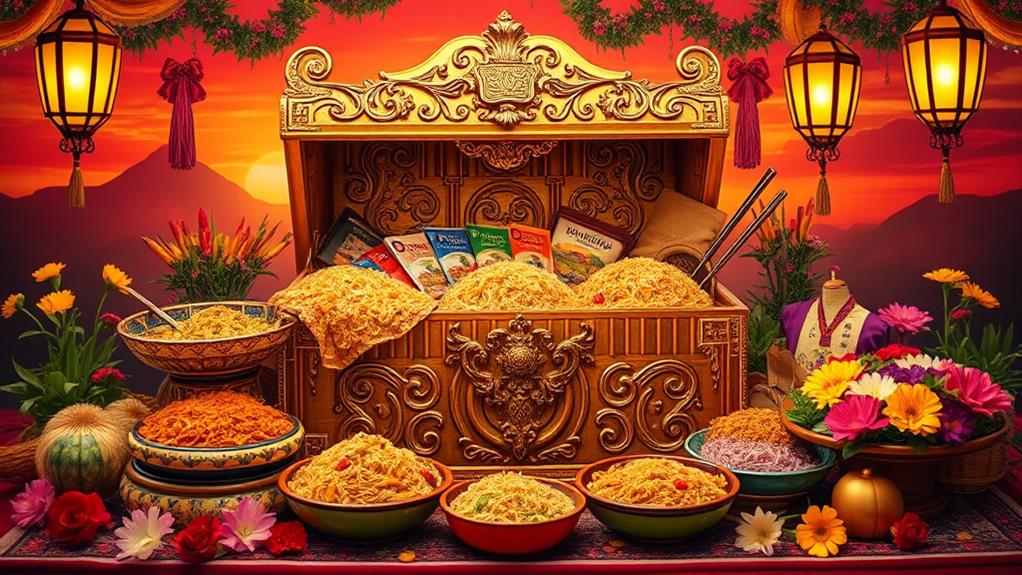
Pancit: A Symbol of Good Fortune and Community in Filipino Culture
In Filipino culture, pancit is a dish that holds significant symbolic value, representing good fortune, long life, and abundance. The long noodles in pancit symbolize longevity, making it a staple dish during birthdays and significant events. This tradition is deeply rooted in the community, emphasizing the importance of family and friendship.
Regional Variations Reflect Cultural Heritage
Pancit has diverse regional variations, such as Pancit Bihon and Pancit Canton, which showcase the rich cultural heritage of the Philippines. These variations reflect the country's culinary influences, including Chinese and Spanish traditions.
Sharing Pancit Fosters Community and Togetherness
When shared with loved ones, pancit fosters community and togetherness. In Filipino culture, sharing meals with family and friends is a way to strengthen bonds and showcase appreciation. By sharing pancit, individuals emphasize the importance of relationships and community in their lives.
Pancit: More Than Just a Dish
Pancit is more than just a delicious meal; it's a symbol of the joy and abundance that comes with sharing meals with others. It represents the happiness and fulfillment that comes from sharing experiences with the people we care about.
Nutritional Value and Health Benefits
Pancit: A Nutrient-Rich Celebration Food
Pancit is more than just a flavorful dish; it's a nutrient-rich meal that offers a wealth of health benefits.
Balanced Nutrition
Pancit provides a balanced source of carbohydrates while being low in fat and naturally gluten-free. This makes it an excellent option for those with dietary restrictions.
Protein-Rich
With a protein content of 32g per serving, pancit is a fulfilling choice for energy-boosting celebrations. This high protein content helps to keep you full and satisfied.
Essential Nutrients
Pancit is rich in essential nutrients like iron and B vitamins, which contribute to overall health and energy levels. These nutrients are vital for maintaining healthy blood cells, nerve function, and energy metabolism.
Vitamins and Minerals
The incorporation of various vegetables like carrots and cabbage in pancit supplies vitamins and minerals, making it a nutritious and well-rounded meal.
Customizable and Inclusive
Pancit accommodates various dietary preferences by allowing customization with lean proteins or plant-based options while maintaining a balance of nutrients. This makes it an excellent choice for celebrations with diverse dietary needs.
Cooking Techniques and Essential Tools
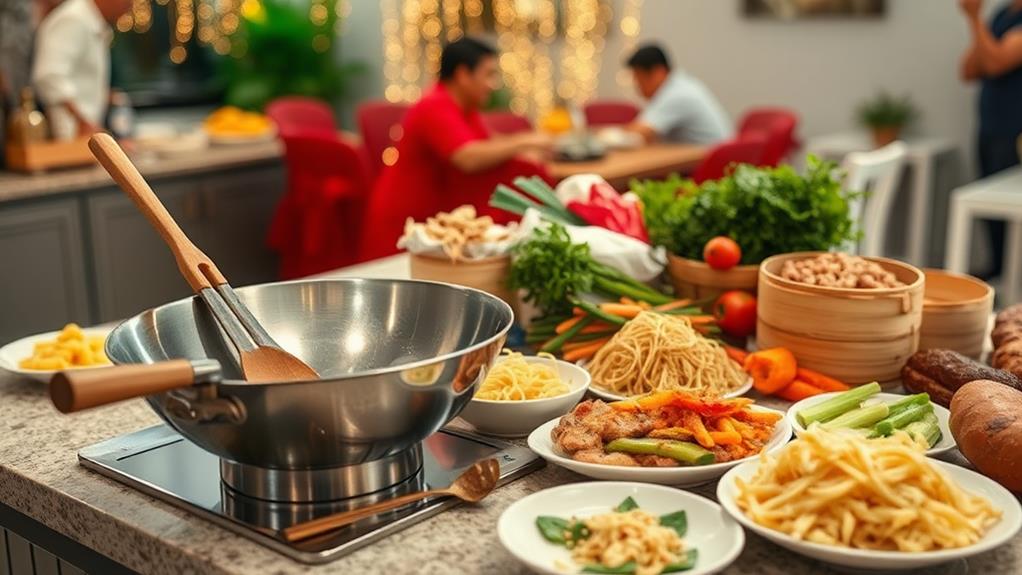
Cooking Pancit Bihon: Essential Techniques and Tools
To cook Pancit Bihon effectively, soak the rice noodles in water until softened, which helps maintain their texture during stir-frying.
Use a large braiser pan or wok for even heat distribution, which is essential for achieving a slight char on the noodles.
When stir-frying, incorporate broth or water gradually to maintain moisture and flavor, adding vegetables towards the end of cooking to preserve their crunchiness.
To prepare ingredients, essential tools are required, including:
- A cutting board and sharp knife for chopping ingredients
- Long metal tongs for handling noodles
- Measuring tools for precise ingredient portions
Adjust seasoning to taste by balancing salty and savory flavors using soy sauce, oyster sauce, and other seasonings.
Personalizing Your Pancit Experience
Personalizing Your Pancit Experience
You can tailor Pancit to your taste preferences by exploring various ingredients, garnishes, and regional twists. This allows you to create a unique recipe that reflects your personality and style.
To customize your Pancit, choose from a variety of proteins and seasonal vegetables to suit your taste preferences. For example, you can use chicken, pork, shrimp, or tofu as protein sources, and add vegetables like carrots, cabbage, or bell peppers.
Garnish creatively to enhance the visual appeal and flavor of your Pancit. Try adding sliced scallions, boiled eggs, and a squeeze of lemon or calamansi to give your dish a pop of color and flavor.
Explore regional variations to add diversity to your special occasion. For instance, you can try making Pancit Malabon, which originated in Malabon City, or Pancit Habhab, which is a popular version from Quezon Province.
Adjust the seasoning of your Pancit by experimenting with different sauces while keeping in mind the sodium content for a healthier option. You can try using patis (fish sauce), soy sauce, or oyster sauce to add flavor to your dish.
Serve with traditional sides to create a well-rounded meal for your special gathering. Consider serving your Pancit with lumpia (Filipino spring rolls) or Filipino BBQ skewers to complement your dish.
Serving Suggestions and Storage Tips
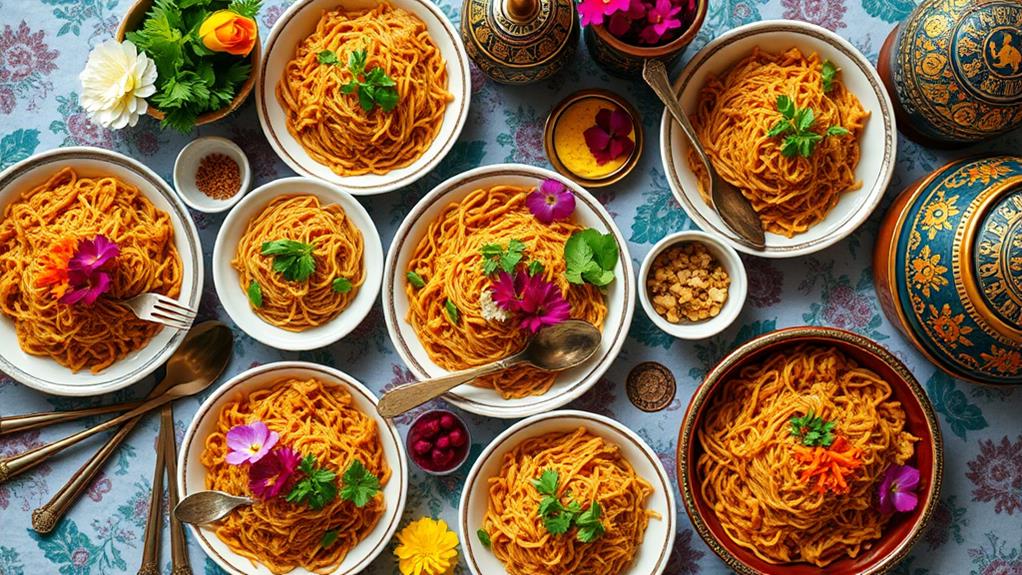
Serving Suggestions and Storage Tips
Consuming Freshly Cooked Pancit
Pancit is best consumed within two hours of cooking to ensure optimal freshness and flavor. This allows you to enjoy the dish warm and at its peak quality.
Storing Leftovers
If you have leftover Pancit, store it in an airtight container in the refrigerator and consume it within two days to maintain quality and prevent bacterial growth.
Reheating Leftovers
When reheating leftover Pancit, add a splash of broth or water to restore moisture if the noodles have dried out. You can reheat on the stovetop or in the microwave.
Elevating Presentation and Flavor
To elevate the presentation and flavors of your Pancit dish, garnish with fresh herbs, lime, or calamansi before serving.
Preparing in Advance
Consider preparing Pancit a day in advance, allowing the flavors to meld, and reheating just before serving to save time during busy occasions.
Can Palabok Noodles be Considered a Type of Pancit for Special Occasions?
Palabok noodles can certainly be considered a type of pancit for special occasions. These flavorful noodles topped with a rich shrimp sauce, garlic, and various toppings are a Filipino favorite. For tips for perfecting palabok noodles, be sure to use fresh ingredients and adjust the seasoning to your taste.
Discovering New Pancit Recipes
The world of Pancit offers a diverse range of recipes to explore.
Beyond the classics, there are many unique variations to discover.
Pancit recipes showcase a variety of flavors and textures. For instance:
- Pancit Bihon Guisado combines vegetables, shrimp, and chicken with thin rice noodles for a flavorful mix.
- Pancit Canton symbolizes abundance and prosperity with its egg noodles stir-fried with various meats and vegetables.
- Pancit Malabon features thick rice noodles topped with a rich shrimp paste and garlic sauce, often accompanied by seafood and boiled eggs.
- Pancit Sotanghon is a comforting glass noodle dish with chicken and mushrooms, lightly seasoned for a heartwarming meal.
- Pancit Palabok smothers bihon noodles in a rich shrimp and pork broth sauce, garnished with chicharron and smoked fish.
These different types of Filipino noodles elevate celebrations with their range of flavors and textures.
Frequently Asked Questions
What Is the Most Popular Type of Pancit?
Pancit Bihon is the most popular type of pancit.
This Filipino favorite features thin rice noodles and a savory flavor. It typically includes a mix of meats like chicken, pork, and shrimp, along with veggies like carrots and cabbage.
Its versatility and cultural significance make it a staple at birthdays and special occasions.
Why Do Filipinos Cook Pancit for Most Occasions?
Pancit holds great cultural significance in Filipino celebrations because it symbolizes long life and prosperity through its noodles. This significance is rooted in the dish's historical origins from Chinese immigrants, which have led to regional varieties.
As a result, pancit has become a staple at family gatherings and celebratory traditions, evoking a sense of warmth and togetherness. For example, it's common to find pancit at birthday parties, weddings, and holiday celebrations, where it's often served alongside other traditional Filipino dishes.
Why Do We Eat Pancit on Birthday?
Pancit is a traditional Filipino dish eaten on birthdays because it symbolizes longevity and good fortune. This belief is deeply rooted in Filipino culture and tradition. According to folklore, consuming pancit on your birthday is believed to bring happiness and good luck in the coming year.
As a staple at family gatherings, pancit showcases cultural heritage and values. The vibrant dish adds to the festive celebrations, and its culinary variety is a testament to the richness of Filipino birthday traditions.
What Is the Difference Between Pancit Habhab and Canton?
Pancit Habhab and Canton are two distinct Filipino noodle dishes with differing origins and cooking techniques.
Pancit Habhab, originating from Quezon province, features flat rice noodles that are simply sautéed to create a light flavor profile.
This dish is often served on banana leaves without utensils, which is a unique characteristic of Habhab.
On the other hand, Canton uses egg noodles and employs vibrant stir-frying to create a rich, savory taste that's enhanced by the use of oyster and soy sauce.
Additionally, Canton is typically served in formal settings, unlike Habhab which is often enjoyed as street food.
